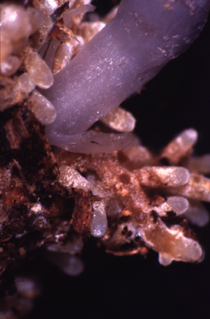Micoheterotròfia: diferència entre les revisions
Robot estandarditza i catalanitza referències, catalanitza dates i fa altres canvis menors |
m Aplicant la plantilla {{ISBN}} per evitar l'enllaç màgic d'ISBN |
||
| Línia 9: | Línia 9: | ||
==Diversitat d'espècies de micoheteròtrofs i fongs hostes== |
==Diversitat d'espècies de micoheteròtrofs i fongs hostes== |
||
Els micoheteròtrofs es troben en un gran nombre de grups de plantes. Tots els [[monotrops]] i orquídies no fotosintètiques són micoheteròtrofs obligats com en els no fotosintètics dins [[Marchantiophyta]] ''[[Cryptothallus]]''. La micoheterotròfia parcial és comuna en la família [[Gencianàcia]] i en algunes [[falgueres]].<ref name="leake94" /><ref name="taylor02">Taylor DL, Bruns TD, Leake JR, Read DJ. 2002. [http://web.archive.org/web/20060901170748/http://mercury.bio.uaf.edu/~lee_taylor/Design/Assets/pdfs/Taylor_ES157Chap15.pdf Mycorrhizal specificity and function in myco-heterotrophic plants.] In: ''Mycorrhizal Ecology'' (Sanders IR, van der Heijden M, eds.), Ecological Studies vol. 157, pp 375–414. Berlin: Springer-Verlag. ISBN |
Els micoheteròtrofs es troben en un gran nombre de grups de plantes. Tots els [[monotrops]] i orquídies no fotosintètiques són micoheteròtrofs obligats com en els no fotosintètics dins [[Marchantiophyta]] ''[[Cryptothallus]]''. La micoheterotròfia parcial és comuna en la família [[Gencianàcia]] i en algunes [[falgueres]].<ref name="leake94" /><ref name="taylor02">Taylor DL, Bruns TD, Leake JR, Read DJ. 2002. [http://web.archive.org/web/20060901170748/http://mercury.bio.uaf.edu/~lee_taylor/Design/Assets/pdfs/Taylor_ES157Chap15.pdf Mycorrhizal specificity and function in myco-heterotrophic plants.] In: ''Mycorrhizal Ecology'' (Sanders IR, van der Heijden M, eds.), Ecological Studies vol. 157, pp 375–414. Berlin: Springer-Verlag. {{ISBN|3-540-00204-9}}. (NOTE: this PDF is from the page proofs, and is not identical to the published version)</ref> |
||
Exemples de fongs parasitats per plantes micoheterotòfes es troben en els fongs [[ectomicorices]], [[micorices arbusculars]], i [[micorices d'orquídies]].<ref name="imhof09">Imhof S. 2009. [http://mycorrhiza.ag.utk.edu/reviews/imhof_2009.pdf Arbuscular, ecto-related, orchid mycorrhizas—three independent structural lineages towards mycoheterotrophy: implications for classification?] ''Mycorrhiza'' 19(6):357–363.</ref> La gran diversitat en famílies de plantes sense emparentar amb membres de micoheteròtrofs suggereix un fenomen d'[[evolució paral·lela]].<ref name="imhof09"/> |
Exemples de fongs parasitats per plantes micoheterotòfes es troben en els fongs [[ectomicorices]], [[micorices arbusculars]], i [[micorices d'orquídies]].<ref name="imhof09">Imhof S. 2009. [http://mycorrhiza.ag.utk.edu/reviews/imhof_2009.pdf Arbuscular, ecto-related, orchid mycorrhizas—three independent structural lineages towards mycoheterotrophy: implications for classification?] ''Mycorrhiza'' 19(6):357–363.</ref> La gran diversitat en famílies de plantes sense emparentar amb membres de micoheteròtrofs suggereix un fenomen d'[[evolució paral·lela]].<ref name="imhof09"/> |
||
Revisió del 05:41, 17 ago 2018

Laq Micoheterotròfia és una relació de simbiosi entre certs tipus de plantes i de fongs en la qual la planta obté part o tota la seva alimentació parasitant un fong.
Relacions entre micoheteròtrofs i fongs hostes

La micoheterotròfia estricta o total (o obligada) es dóna quan una planta no fotosintètica aconsegueix tots els nutrients del fong que parasita. La micoheterotròfia parcial (o facultativa) és quan la planta és capaç de fotosintetitzar però obté un suplement de nutrients del fong. En algunes orquídies part del seu cicle vital pot ser de micoheterotròfia obligada i part del seu cicle facultativa.[2]
Diversitat d'espècies de micoheteròtrofs i fongs hostes
Els micoheteròtrofs es troben en un gran nombre de grups de plantes. Tots els monotrops i orquídies no fotosintètiques són micoheteròtrofs obligats com en els no fotosintètics dins Marchantiophyta Cryptothallus. La micoheterotròfia parcial és comuna en la família Gencianàcia i en algunes falgueres.[2][3]
Exemples de fongs parasitats per plantes micoheterotòfes es troben en els fongs ectomicorices, micorices arbusculars, i micorices d'orquídies.[4] La gran diversitat en famílies de plantes sense emparentar amb membres de micoheteròtrofs suggereix un fenomen d'evolució paral·lela.[4]
Referències
- ↑ Yang, S; DH Pfister «Monotropa uniflora plants of eastern Massachusetts form mycorrhizae with a diversity of russulacean fungi». Mycologia, 98, 4, 2006, pàg. 535–540. DOI: 10.3852/mycologia.98.4.535. PMID: 17139846.
- ↑ 2,0 2,1 Leake JR. 1994. The biology of myco-heterotrophic ('saprophytic') plants. New Phytologist 127: 171–216. doi:10.1111/j.1469-8137.1994.tb04272.x. Warning: large document
- ↑ Taylor DL, Bruns TD, Leake JR, Read DJ. 2002. Mycorrhizal specificity and function in myco-heterotrophic plants. In: Mycorrhizal Ecology (Sanders IR, van der Heijden M, eds.), Ecological Studies vol. 157, pp 375–414. Berlin: Springer-Verlag. ISBN 3-540-00204-9. (NOTE: this PDF is from the page proofs, and is not identical to the published version)
- ↑ 4,0 4,1 Imhof S. 2009. Arbuscular, ecto-related, orchid mycorrhizas—three independent structural lineages towards mycoheterotrophy: implications for classification? Mycorrhiza 19(6):357–363.
Bibliografia
- Hershey DR. 1999. Myco-heterophytes and parasitic plants in food chains. American Biology Teacher 61: 575–578.
- Hibbett DS. 2002. When good relationships go bad. Nature 419: 345–346.
- Werner PG. 2006. Myco-heterotrophs: hacking the mycorrhizal network. Mycena News 57(3): 1,8.
- Dr. Martin Bidartondo: Selected publications
- D. Lee Taylor Lab: Recent Publications
- M.-A. Selosse's publications
Enllaços externs
- The Strange and Wonderful Myco-heterotrophs The Parasitic Plant Connection, SIU Carbondale, College of Science.
- Wayne's Word Noteworthy Plant For June 1997: Fungus Flowers – Flowering Plants that Resemble Fungi by WP Armstrong.
- Fungus of the Month for October 2002: Monotropa uniflora by Tom Volk, TomVolkFungi.net
- Martín's Treasure Chest – images of myco-heterotrophs by mycologist Martín Bidartondo.
